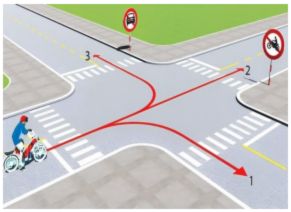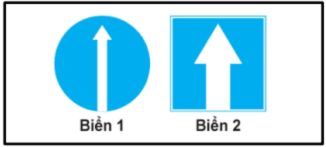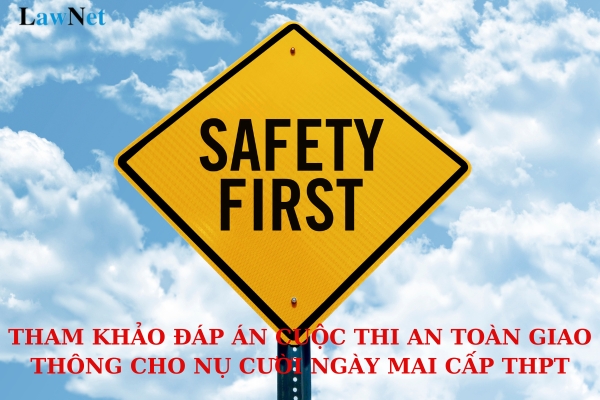What are answer keys for the Competition "An toàn giao thông cho nụ cười ngày mai" for upper secondary school students in Vietnam in the school year 2024-2025?
What are answer keys for the Competition "An toàn giao thông cho nụ cười ngày mai" for upper secondary school students in Vietnam in the school year 2024-2025?
Below are the reference answers for the Competition "An toàn giao thông cho nụ cười ngày mai" for upper secondary school students in the academic year 2024-2025.
Câu 1. Theo Luật Trật tự, an toàn giao thông đường bộ 2024, hành vi nào sau đây bị nghiêm cấm?
A. Giao xe cơ giới, xe máy chuyên dùng cho người không đủ điều kiện theo quy định củapháp luật để điều khiển xe tham gia giao thông đường bộ. (khoản 7 Điều 9 Luật Trật tự, an toàn giao thông đường bộ 2024)
B. Điều khiển phương tiện tham gia giao thông đường bộ trước khi uống rượu bia.
C. Sử dụng quyền của xe ưu tiên khi làm nhiệm vụ.
D. Hỗ trợ người bị tai nạn giao thông đi cấp cứu.
Câu 2. Người tham gia giao thông đường bộ nếu gặp nhiều báo hiệu đường bộ, cần ưu tiênthực hiện báo hiệu nào nhất?
A. Hiệu lệnh của người điều khiển giao thông.
B. Tín hiệu đèn giao thông.
C. Thiết bị âm thanh báo hiệu đường bộ.
D. Biển báo hiệu đường bộ.
Câu 3. Trường hợp nào sau đây không được phép vượt bên phải?
A. Khi xe điện đang chạy giữa đường.
B. Khi đường có đông phương tiện lưu thông.
C. Khi xe phía trước có tín hiệu rẽ trái hoặc đang rẽ trái.
D. Khi xe chuyên dùng đang làm việc trên đường mà không thể vượt bên trái được.
Câu 4. Khi muốn chuyển hướng, người điều khiển phương tiện phải làm gì? A. Dừng xe lại để quan sát.
B. Tăng tốc độ và có tín hiệu hướng rẽ.
C. Giảm tốc độ và có tín hiệu báo hướng rẽ.
D. Giảm tốc độ, bật đèn tín hiệu và xoay người ra sau quan sát.
Câu 5. Theo hướng mũi tên, những hướng nào xe gắn máy đi được?

A. Hướng 1 và 2.
B. Hướng 1 và 3.
C. Hướng 2 và 3.
D. Cả ba hướng.
Câu 6. Ban đêm, xe cơ giới đi ngược chiều nhau, đèn chiếu sáng phải sử dụng như thế nào là đúng quy tắc giao thông?
A. Chuyển từ đèn chiếu gần sang đèn chiếu xa.
B. Nháy đèn liên tục để phương tiện ngược chiều dễ nhận biết.
C. Chuyển từ đèn chiếu xa sang đèn chiếu gần.
D. Tắt đèn, sau khi phương tiện ngược chiều đi qua thì mở đèn trở lại và lưu thông bình thường.
Câu 7. Điều kiện nào dưới đây là phù hợp đối với người lái xe khi tham gia giao thông theo Luật giao thông đường bộ năm 2008?
A. Người đủ 15 tuổi trở lên được lái xe gắn máy có dung tích xi-lanh dưới 50 cm3.
B. Người từ 15 tuổi trở lên được lái xe gắn máy có dung tích xi-lanh dưới 50 cm3.
C. Người đủ 16 tuổi trở lên được lái xe gắn máy có dung tích xi-lanh dưới 50 cm3. (điểm a khoản 1 Điều 60 Luật giao thông đường bộ 2008)
D. Người từ 16 tuổi trở lên được lái xe gắn máy có dung tích xi-lanh dưới 50 cm3.
Câu 8. Biển báo nào báo hiệu hướng đi thẳng phải theo?

A. Biển số 1.
B. Biển số 2.
C. Cả hai biển 1 và 2.
D. Không có biển nào.
Câu 9. Chủ đề năm An toàn giao thông 2024 là gì?
A. An toàn giao thông cho trẻ em.
B. Đã uống rượu, bia không lái xe.
C. Nâng cao hiệu lực, hiệu quả thực thi pháp luật bảo đảm trật tự an toàn giao thông.
D. Thượng tôn pháp luật để xây dựng văn hoá giao thông an toàn.
Câu 10. Theo Luật giao thông đường bộ năm 2008, cơ quan nào sau đây không có trách nhiệm tuyên truyền, phổ biến, giáo dục pháp luật về giao thông đường bộ?
A. Uỷ ban nhân dân tỉnh trong phạm vi nhiệm vụ, quyền hạn của mình.
B. Uỷ ban nhân dân huyện trong phạm vi nhiệm vụ, quyền hạn của mình.
C. Mặt trận Tổ quốc Việt Nam và các tổ chức thành viên của Mặt trận.
D. Sở Vệ sinh thực phẩm trong phạm vi nhiệm vụ, quyền hạn của mình.

What are answer keys for the Competition "An toàn giao thông cho nụ cười ngày mai" for upper secondary school students in Vietnam in the school year 2024-2025? (Image from Internet)
What is the outline for questions in the Competition "An toàn giao thông cho nụ cười ngày mai" for upper secondary school students in Vietnam in the school year 2024-2025?
Below is the outline for questions that students can refer to when participating in the contest:
Question: Using a mind map, summarize the knowledge learned from theCompetition "An toàn giao thông cho nụ cười ngày mai" for upper secondary school students. With the knowledge learned and real-life experience, list models and solutions that contribute to building a traffic culture among youth and students.
Reference Outline:
1. Summarize knowledge through a mind map about the "An toàn giao thông cho nụ cười ngày mai" program
Students can present a mind map focusing on the main learned content, including:
(1) Traffic laws and safety regulations:
- Classification of vehicles (motorcycles, cars, bicycles).
- Basic regulations such as: not running red lights, wearing helmets, not using phones while driving.
(2) Traffic signs:
- Prohibition signs (no turning, no parking).
- Warning signs (curves, intersections with railways).
- Instructional signs (priority road, straight path).
(3) Right-of-way rules:
- Yielding at intersections, for ambulances, fire trucks.
- Giving priority to pedestrians.
(4) Importance of law compliance:
- Ensuring safety for oneself and others.
- Preventing accidents and reducing traffic congestion.
The mind map can include the main branches above and smaller details related to each group.
2. Models and solutions to contribute to building traffic culture among youth and students
Students can divide this section into categories as follows:
(1) Model of traffic education communication:
Organizing extracurricular activities, seminars: Schools can organize safety traffic education sessions, inviting experts or traffic police to speak. These sessions will help students understand the laws and their roles in traffic participation.
Media campaigns in school: Create posters, banners, or videos within the school's premises to remind students of safe traffic rules.
(2) Establishing volunteer traffic guide teams:
Student traffic guide teams: Older students can volunteer to guide traffic during school dismissals. They can assist younger students and control disorder in front of school gates.
Direct guidance from teachers or staff: Teachers and school union officials can participate in guiding students for safe transit during dismissals or peak hours.
(3) Commitment to traffic safety:
Create commitments to not violate traffic laws: Schools can encourage students to sign commitments such as not running red lights, not using vehicles before the requisite age. This motivates students to comply intentionally.
Set goals for building traffic culture starting from students: Schools can create a long-term program where students actively participate in communication and adherence, spreading awareness to the community.
(4) Applying technology in traffic law education
Using traffic simulation technology: Utilizing applications or software for realistic traffic simulation helps students practice and handle situations on the road.
Online traffic quizzes: Organize online test sessions on traffic laws to help students reinforce their knowledge.
Conclusion
Building a traffic culture among youth and students requires a combination of education, self-awareness, and creative models and solutions within schools. Proper communication and support from families and schools will foster a generation cultured and responsible in traffic participation.
What are the duties of upper secondary school students in Vietnam?
Based on Article 34 of the Regulations on lower secondary schools, upper secondary schools, and schools with multiple educational levels issued with Circular 32/2020/TT-BGDDT, students have the following duties:
- Fulfill learning and training tasks according to the school's education program and plan.
- Respect parents, school staff, teachers, peers; comply with school rules and national laws.
- Exercise, maintain personal hygiene.
- Participate in school, class, Ho Chi Minh Young Pioneers, Ho Chi Minh Communist Youth activities; assist at home, engage in social and environmental activities, adhere to traffic safety.
- Preserve school and public property; contribute to the reputation and heritage of the school.
What are regulations on the conduct and dress codes for upper secondary school students in Vietnam?
According to Article 36 of the Regulations on lower secondary schools, upper secondary schools, and schools with multiple educational levels issued with Circular 32/2020/TT-BGDDT, the conduct and dress codes for upper secondary school students are as follows:
- Conduct, language, and behavior must be courteous, respectful, friendly, culturally appropriate, and suited to the ethical standards and lifestyles of the upper secondary school age group.
- Student attire must be neat, clean, age-appropriate, and suitable for learning and school activities. Depending on the conditions of each school, the principal may decide to require uniforms if agreed upon by the school and the Parent Representative Council.

